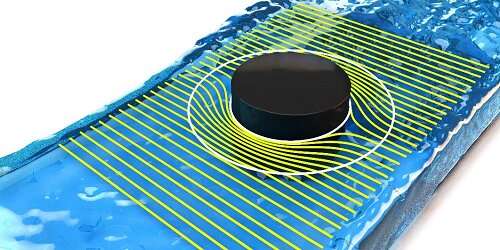August 14, 2019 report
Two teams build invisibility cloaks for water applications

Two teams of researchers, one in Korea, the other China, have devised two different types of invisibility cloaks for water applications. Both teams have published papers describing their work in the journal Physical Review Letters.
In recent years, scientists have created invisibility cloaks based on metamaterials—such materials bend light in such a way as to conceal an object. Other work has shown that other types of wavelengths can be cloaked, as well, including infrared light, thermal, sound and microwaves. Interestingly, earlier this year, a team in France found evidence that suggested ancient Roman structures had been built with similar cloaking properties, helping to explain how they have survived earthquakes over the years. Efforts to carry out similar work with water-based applications have been less successful—most have relied on pumps, which require an external power source and also suffer from viscosity issues. In these two new efforts, both teams created passive cloaks that have possible real-world applications.
In the first effort, a team with members from Seoul National University and Dankook University created a cloak by enclosing an object within a ring of 523 specially designed small pillars—the arrangement of the pillars deflected incoming fluid flow, resulting in zero drag on the object that was hidden. The group proved their concept by demonstrating their cloak in a water-filled tank with a cylinder in the center—there was no wake associated with the cylinder. They suggest that their cloak could possibly be used someday to reduce drag on ships or other watercraft.
In the second effort, a team with members from Beijing University and Xiamen University had a different goal—they wanted to reduce wave height in a specified channel. Their cloak (based on waveguide cloaks) consisted of installing long, thin iron platforms on the bottom of a tank in its corners. The platforms were designed in such a way as to steer waves around an object in the center of a tank. The researchers suggest their cloak could be used to mitigate wave damage to ships in port. They plan to next experiment with their platforms in a real-world environment.
More information: Broadband Waveguide Cloak for Water Waves, Physical Review Letters (2019). journals.aps.org/prl/abstract/ … ysRevLett.123.074501
Hydrodynamic Metamaterial Cloak for Drag-Free Flow, Physical Review Letters (2019). journals.aps.org/prl/abstract/ … ysRevLett.123.074502
Journal information: Physical Review Letters
© 2019 Science X Network



















